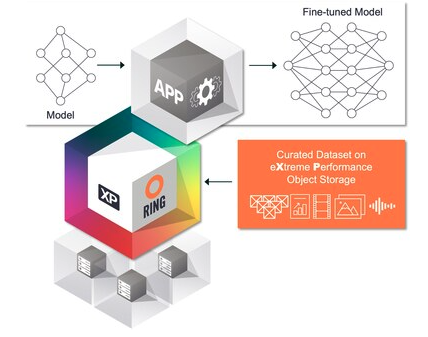Scality Targets AI with RING Add-on

Scality has released an AI add-on to its flagship RING system for object and file storage. Dubbed RING XP, Scality says the new software delivers microsecond response times for feeding AI modeling and fine-tuning workflows, while supporting the storage management and security functions of RING.
The news highlights a trend among longstanding object storage vendors to shoulder into enterprise AI by delivering workload access to unstructured data—text, video, images, messaging, and other types of data that don’t conform to database schemas. These data items have become rich sources of information for shaping AI models. But up to now, object file systems haven’t been fast enough to meet the latency requirements of expensive AI systems. Scality and a range of competitors are looking to change that as object storage moves to the forefront of AI processing.
Performance Fit for AI
Scality claims RING XP runs “an order of magnitude” faster than AWS’s S3 Express One Zone, Amazon’s storage class designed to accelerate the performance of S3 object storage by 10X (according to AWS), achieving "single-digit millisecond latency." In contrast, Scality says that RING XP can achieve rates in the "hundreds of microseconds" when handling data items of 4KB or less.
While Scality’s claim isn't independently verified, it demonstrates the priority Scality’s put on performance and speed, which are key to efficiency in delivering data to AI workloads running on expensive hardware.
RING XP improves RING performance in several ways, including streamlining the object storage API to support a limited set of operations. RING XP also relies on what Scality terms optimizations for small file I/O acceleration, or the system’s ability to parse and distribute objects for maximum performance. Added to this mix is RING XP’s reliance on all-flash, x64-based NVMe storage servers from Lenovo, Supermicro, Dell, and HPE that are all based on AMD EPYC components.
RING supported those servers before, but not in the same way. “Yes, standard RING is hardware-agnostic, so it was previously supported on a wide range of Intel- and AMD-based all-flash servers,” said Paul Speciale, chief marketing officer at Scality. “However, this is not the same as fully leveraging and exploiting the performance potential of the platform, which RING XP now does.”
Scality’s link to standard hardware is important because it allows RING and RING XP to replace proprietary hardware-based network attached storage (NAS) systems with software-based storage that runs on a variety of hardware platforms. Scality’s products also work with cloud-based storage from AWS, Microsoft Azure, or Google Cloud.

Scality's diagram of RING XP. Source: Scality
Management and Security Based on RING
Scality stresses that RING XP is an augmentation to the underlying RING system, which delivers a repository for exabytes of warm-to-cold data in object or file formats. The system features monitoring and management functions such as tracking storage capacity, CPU usage, memory usage, and the status and latency of disks and other system elements.
RING XP also benefits from RING’s so-called CORE5 ransomware protection, which comprises the following five levels of cyber protection or resiliency:
- API-level protection via support for the AWS S3 Object Lock API, which assures data immutability against ransomware attacks.
- Data-level protection via zero-trust architecture to prevent data exfiltration, along with AWS authentication and identity access management, firewall compatibility, and AES 256-bit data encryption.
- Storage-level protection via distributed erasure coding, which makes stored data incomprehensible to attackers while allowing data to be fully reconstructed if it’s corrupted or lost.
- Geographic resilience based on multisite storage of backups.
- Architectural resilience that limits administrator access and the ability to change data. Scality says its system supports “no deletes or overwrites, ever.”

Scality Core5 ransomware protection. Source: Scality
Object Storage Players Shift to AI
Scality, founded in 2009 and headquartered in San Francisco with offices worldwide, is among a group of mature enterprise object storage firms intent on bringing their data management technology into the AI era. Competitors include Cloudian (founded 2011) and Pure Storage (founded 2009), to name just two.
Scality's AI ambitions haven't ended with RING XP. Scality CMO Speciale told us that, while Scality hasn’t made any announcements, they are “exploring multiple angles for supporting NVIDIA-based technology platforms,” including linking directly to BlueField DPUs; linking to NVIDIA’s GPUDirect, which allows storage to directly feed into GPU memory; and working with NVIDIA Big Accelerator Memory (BaM), a technology co-developed by NVIDIA that lets GPUs access storage directly, bypassing CPUs.
RING XP is available now and free to RING customers, which include Bloomberg, Comcast, Orange, Rackspace, SeqOIA Genomique, and Telent, to name just a few.
Futuriom Take: With RING XP, Scality addresses a key market opportunity to support AI workloads with complex unstructured data storage technology that’s been proven in the enterprise space.
















